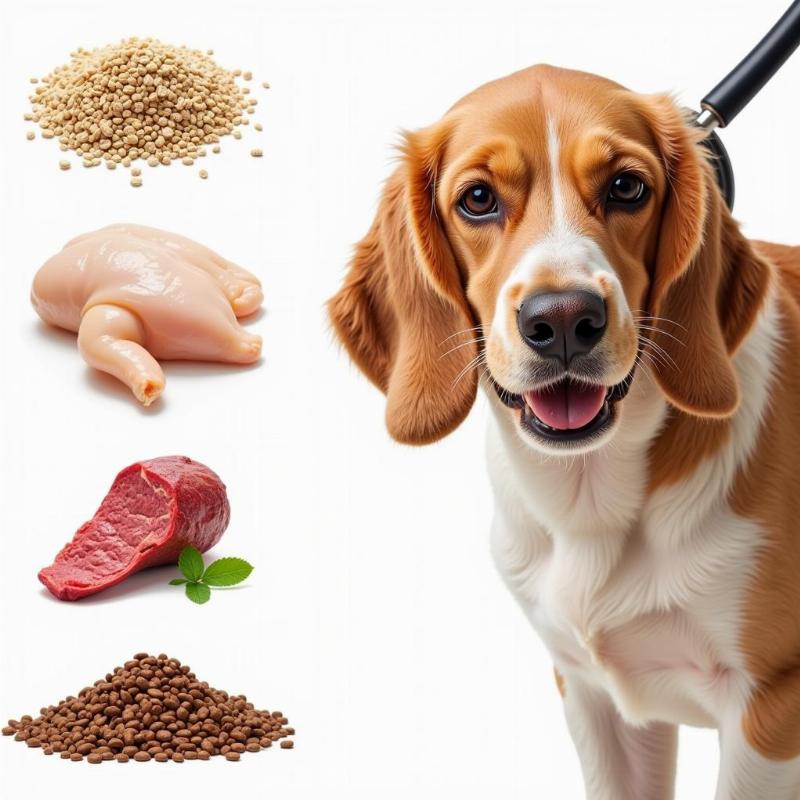Rachel Fusaro isn’t a recognized brand of dog food in the US. However, many pet owners, like Rachel Fusaro herself, are constantly searching for the “best” dog food for their furry companions. This guide will explore factors to consider when choosing a high-quality dog food that meets the specific needs of your dog, regardless of whether it’s a trendy brand or a classic choice. We’ll cover everything from nutritional requirements and ingredient lists to understanding labels and recognizing common marketing tactics.
Choosing the best dog food can feel overwhelming. The pet food aisle is packed with options promising various benefits, from shiny coats to improved digestion. However, deciphering which brand truly delivers on its promises requires a deeper understanding of dog nutrition and label reading.
Decoding Dog Food Labels: A Critical Skill for Pet Owners
The information printed on a dog food bag is more than just marketing; it’s a legal document outlining the product’s contents. Understanding how to read and interpret this information is essential for making informed decisions about your dog’s diet. Pay close attention to the guaranteed analysis, which lists the minimum percentages of crucial nutrients like protein, fat, fiber, and moisture. Also, scrutinize the ingredient list, which is arranged in descending order by weight. Look for whole meat sources and avoid fillers like corn, wheat, and soy.
Nutritional Needs: Tailoring Your Choice to Your Dog’s Life Stage
A puppy’s nutritional needs differ significantly from those of an adult or senior dog. Puppies require higher levels of protein and fat to support rapid growth and development, while senior dogs often benefit from lower-calorie diets with added joint support supplements. Consider your dog’s breed, size, activity level, and any existing health conditions when selecting a food. For instance, large breed puppies require specific formulations to prevent rapid growth that can lead to skeletal issues.
Beyond the Basics: Addressing Specific Dietary Concerns
Many dogs have allergies or sensitivities to certain ingredients, such as chicken, beef, or grains. If your dog experiences digestive issues, skin irritations, or other allergy symptoms, consider switching to a limited ingredient diet (LID) or a hypoallergenic formula. Always consult with your veterinarian before making significant dietary changes, especially if your dog has a pre-existing medical condition. They can guide you toward the most appropriate food and ensure a smooth transition.
 Dị ứng và nhạy cảm với thức ăn cho chó
Dị ứng và nhạy cảm với thức ăn cho chó
Navigating the American Pet Food Market
The US offers a vast array of dog food options, from nationally recognized brands to smaller, specialized companies. Researching different brands and comparing their ingredients, nutritional profiles, and manufacturing processes is crucial. Look for brands that adhere to the Association of American Feed Control Officials (AAFCO) guidelines and prioritize quality ingredients. Don’t be swayed by marketing hype alone; focus on the facts.
Prioritizing Your Dog’s Health: Making Informed Choices
Ultimately, the “best” dog food is the one that meets your individual dog’s specific needs and helps them thrive. Don’t be afraid to experiment with different brands and types of food (kibble, wet, raw, etc.) to find what works best for your furry friend. Regular veterinary checkups and open communication with your vet are essential for monitoring your dog’s health and making any necessary adjustments to their diet.
Conclusion: Investing in Your Dog’s Wellbeing
Finding the perfect dog food, like searching for the mythical “Rachel Fusaro best dog food,” might seem challenging, but by focusing on quality ingredients, understanding your dog’s needs, and consulting with your veterinarian, you can make informed choices that support their long-term health and happiness. Remember, a healthy diet is a cornerstone of a happy and vibrant life for your beloved companion.
FAQ:
- How can I tell if my dog is allergic to their food? Common signs include itching, skin irritation, digestive upset, and ear infections.
- What are some good sources of protein for dogs? Chicken, beef, lamb, fish, and eggs are all excellent protein sources.
- Should I feed my dog grain-free food? There is no one-size-fits-all answer. Consult your vet to determine if a grain-free diet is appropriate for your dog.
- What does AAFCO stand for? AAFCO stands for the Association of American Feed Control Officials. They establish nutritional guidelines for pet food in the US.
- How often should I change my dog’s food? Avoid frequent changes unless necessary due to allergies or other health concerns. Gradual transitions are always recommended.
- What should I look for in a high-quality dog food? Whole meat sources, balanced nutrition, and adherence to AAFCO guidelines are key indicators of quality.
- Is homemade dog food a good option? Homemade diets can be healthy, but it’s crucial to work with a veterinary nutritionist to ensure they are nutritionally balanced.
Beautdogs.us is your premier source for expert advice on all things dog-related, from breed information and grooming tips to finding the perfect products for your canine companion. We’re dedicated to providing comprehensive, reliable, and engaging content for dog owners of all experience levels. Whether you’re a seasoned pet parent or just starting your dog-owning journey, Beautdogs.us is here to help you navigate the wonderful world of canine companionship. Contact us today at [email protected] or +1 501-555-7529 for personalized guidance.